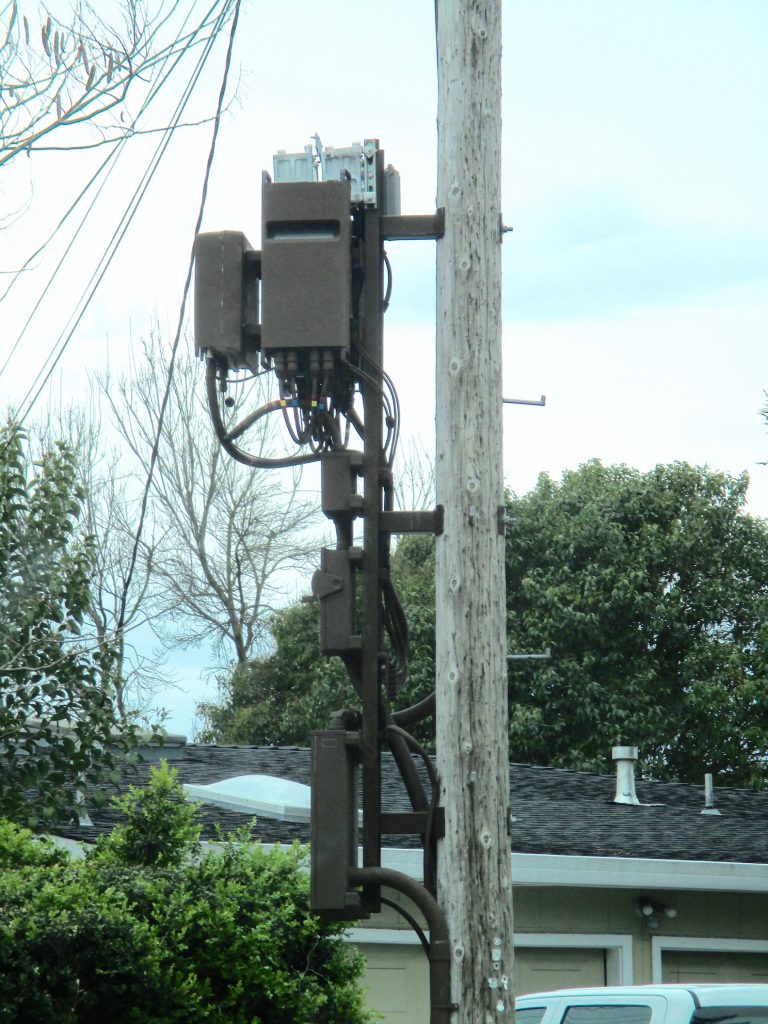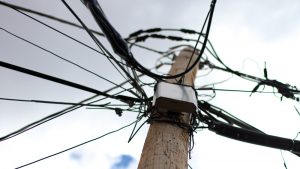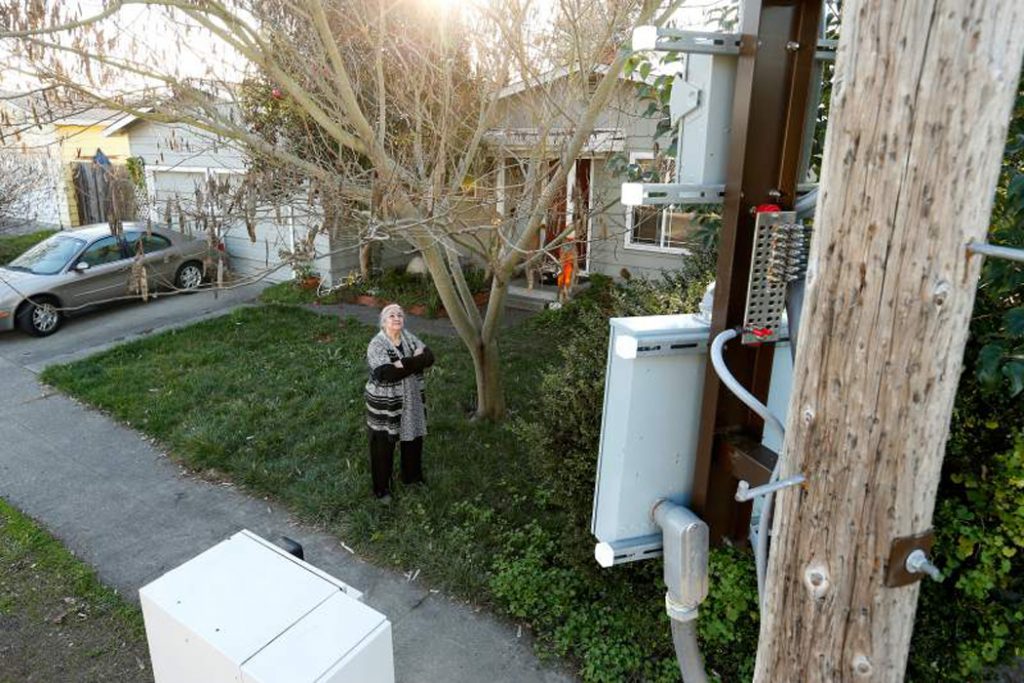The Deck is Stacked …
A look at reported lobbyist communications from February 2020 to February 2021 between Canada’s big telecom companies and government officials reveals that big telecom lobbies Ottawa twice a day.
And It’s Complicated …
Telecommunication regulators and industry are now pushing to take away the limited local input we have over the placement of small cell antennas in our communities.

Bye Bye Bylaws
Telecommunications fall under federal jurisdiction in Canada, as most municipal leaders are quick to point out. In Canada, unlike in the US, municipal governments are generally prohibited from creating bylaws or ordinances that allow them to regulate anything to do with antennas or telecommunications. Several legal precedents support this and help pave the way for 5G.
In Bell Canada Inc v The City of Calgary, 2018, the Court of Queen’s Bench of Alberta ruled that a bylaw of the City of Calgary regulating the process for access and use of municipal rights-of-way does not apply to telecommunications providers.
In Telus Communications Co. v. City of Toronto (2007), the Ontario Superior Court ruled that the City of Toronto could not enforce a site plan bylaw that was not specific to, but would apply to, new antenna sitings, as this could allow the City to impede Telus’ ability to maintain a functioning network.
 Laws that Support us in Putting a Monkey Wrench in the Deployment of 5G
Laws that Support us in Putting a Monkey Wrench in the Deployment of 5G
There is one uncontested Canadian legal precedent that challenges the notion of exclusive federal jurisdiction over telecommunication undertakings.
In R. v. City of New Westminister (1965) the BC Court of Appeal ruled that a municipal licensing bylaw applied to a federal undertaking. The Court held that the City of New Westminster could refuse to grant a business license to a federally-regulated cable company because the cable company’s federal license did not exclude it from being bound by provincial laws and municipal regulations concerning business operations.
Based on the Canadian Court’s interpretation of Section 43(5) of the Telecommunications Act, two other uncontested legal precedents support communities in denying access, in some instances, to the infrastructure needed for 5G:
1) The first says the CRTC is not authorized to mandate that the fiber or equipment needed for 5G and cell towers be placed on electric utility poles

1. Amend theTelecommunications Act to take away local governments’ and private landowners’ right to refuse antennas on their property, therefore consolidating federal authority over the infrastructure that will support 5G.
2. Create a “Canadian Communications Commission” which will be given the final say in all radiocommunication and telecommunication siting matters and dispute resolutions, and will have the power to override any existing provincial or municipal rights that may impede 5G.
Learn more Here: See Section 5.2 of ISED’s Spectrum Outlook 2018 to 2022: “Antenna Sites and Structures”
Here: See Section 2.4 of the January 2020 Report from the Broadcasting and Telecommunications Legislative Review Panel “Unlocking the advanced networks of tomorrow”
And Here: See CRTC wants more power over 5G infrastructure placement, chairman tells Senate

Who has the Power to Place Small Cells by our Homes?
At the Federal Level:
Innovation, Science, and Economic Development Canada (ISED) has the final say over microcell placement in Canada. Their rules allow microcells to be placed on existing structures by our homes without any public consultation. Installations may also be placed on existing towers without seeking local government consent.
ISED does not currently have the right to force public or private landowners to allow small cell antennas on their property.
At the Local Level:
Telecoms are required to notify whoever owns the street you live on – either your local government or the provincial government – when they want to install a microcell there. They must provide government officials with some details of their plans.
If the proposal meets all local requirements, then your municipal government is required to agree to the plan, and it’s a done deal. At that point, site permits giving the telecom authorization to install the microcell on your street will be signed. If the microcell will be attached to a utility pole, street lamp or other structure, permission must also be obtained from whoever owns that. Both the owner(s) of the right-of-way and the structure usually charge an annual fee to the telecom for each microcell installed.
Note: Pole-leasing and blanket permitting agreements between the owner(s) of the public rights-of-way, the utility poles or lampposts, and telecommunications providers may already be in place before microcell applications are submitted. Contact whoever is in charge of antenna applications where you live to find out what agreements exist, permits are in process, and antenna siting policies are in place.

How Local Governments May Protect Their Citizens
Learn from the Best HERE are some examples of what other Local Leaders are doing about this issue.
Establish the Game Rules Creating an Antenna Siting Protocol that includes small cell antennas gives your local government some leverage in the siting of microcells. Use this handy guide and create antenna protocols that are as protective as possible.
Create More Protective Radiation Exposure Standards The federal government says all antennas must conform to Canada’s inadequate radiation exposure guideline Safety Code 6, but Provincial law charges local governments with protecting residents’ health. Local governments may establish their own, more protective standards, adding an additional layer of regulation on top of federal guidelines and may integrate these standards into Antenna Siting Protocols. Antennas installed on both Salt Spring Island, BC and in Toronto are asked to conform to standards that are 60-75 times more protective than Heath Canada’s guidelines.
Ask for What You Need This document shows how the Town Council of Western Springs, Illinois responded to a small cell siting application made by Crown Castle. As a result, the telecom withdrew its application.
The Right to Refuse? If a proposed microcell installation does not comply with a local government’s requirements, as laid out in its Antenna Siting Protocol, a municipality may issue a letter of non-concurrence to ISED, refusing the antenna. There is no precedent for how ISED would react if a local government refused all proposed microcell installations, but policy decisions to date weigh heavily in telecoms’ favour. If a carrier cannot reach what they consider to be an acceptable agreement with a local government, then the CRTC and/or ISED can enforce its own conditions upon a municipality.
Private & Public Property If a telecom wants to place a microcell on private property, like a church, whoever owns that property must give their signed permission before the antenna may be installed, usually for a fee. If the microcell is to be placed on public property, even if it is not on an existing structure, municipal governments may choose to forgo a public consultation process. Local governments are required, however, to notify nearby residents before antennas are installed on public property.
 A Microcell has been Installed by my Home. What Can I Do About It?
A Microcell has been Installed by my Home. What Can I Do About It?
Verify with your local land use authority that they have given permission for that microcell to be installed.
If the microcell is “legal”, its removal depends on changes being made to federal telecommunications policy and perspective.
To facilitate policy change, educate yourself and others – including friends, family, neighbours, co-workers, health practitioners, educators, union reps, environmentalists, the media, and elected representatives – on the health, environmental, privacy, property value and public safety aspects of this issue. Share this site. Work together to create a “new normal” – one rooted in safe and healthy high-speed connectivity.
